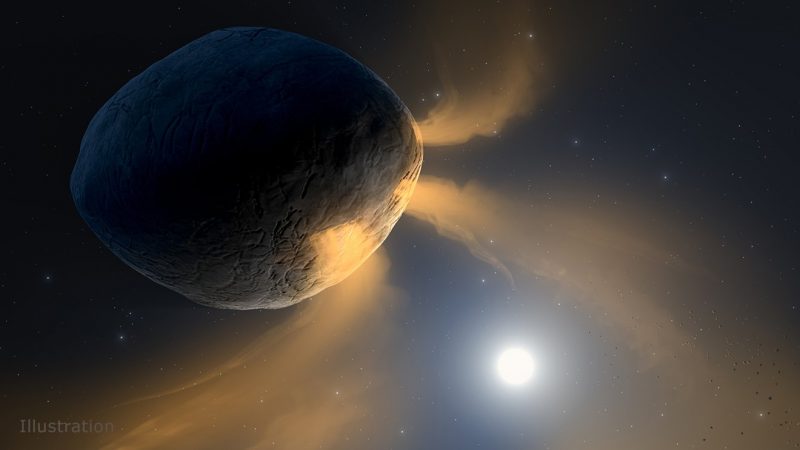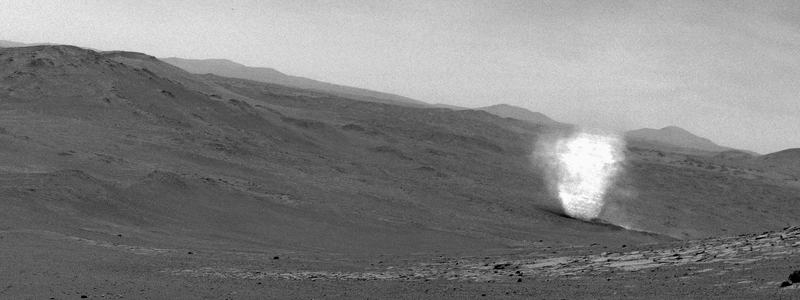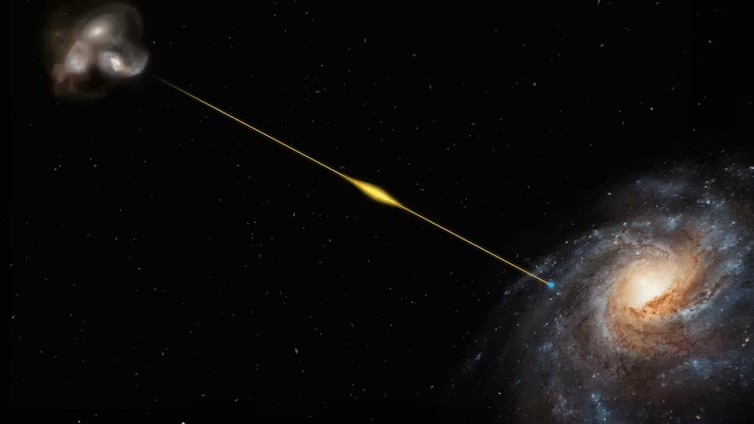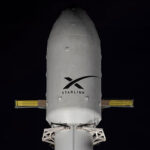Now Reading: Mysterious 3200 Phaethon: Parent to the Geminids
-
01
Mysterious 3200 Phaethon: Parent to the Geminids
Mysterious 3200 Phaethon: Parent to the Geminids


The Geminid meteor shower is peaking on the overnight of December 13-14. Read more about 2024’s Geminid meteor shower.
The 2025 EarthSky lunar calendar makes a great gift. Get yours today!
Weirdly comet-like 3200 Phaethon
Most meteors in annual showers have comets as their sources. But not December’s Geminid meteors, whose source, known as 3200 Phaethon, is a strange hybrid of an asteroid and a comet. This “rock-comet” isn’t icy, like a comet is. But it brightens as it nears the sun, as comets do. And it’s been observed to have a tail when nearest the sun. Plus, it spawns the Geminid meteor shower. And so scientists have long puzzled over 3200 Phaethon. How can a rocky asteroid leave behind debris that sparks a meteor shower? Where does its tail come from?
In 2023, a couple of new studies provided insights on 3200 Phaethon, parent object of one of the year’s best meteor showers.
New research from Lowell Observatory
The Planetary Science Journal published a new study about 3200 Phaethon in April 2023.
On December 13, 2023, Spaceweather.com quoted astronomer Karl Battams of the U.S. Naval Observatory – a co-author of the April study – as saying:
Our work has upended years of belief about 3200 Phaethon, the source of the Geminids. It’s not what we thought it was.
In other words, since its discovery in 1983, 3200 Phaethon has appeared to be a rocky asteroid. NASA’s STEREO spacecraft first observed its tail – which appears when 3200 Phaethon passes near the sun in its 524-day orbit – in 2009 and 2012.
But, according to the story in Spaceweather.com, Qicheng Zhang at Lowell Observatory in Flagstaff was “never convinced.” Spaceweather.com explained:
For one thing, the Geminid debris stream is massive (1,013 kg or 2,233 pounds), while the tail of 3200 Phaethon is puny, providing less than 1% of the mass required to explain the Geminids.
‘The tail we see today could never supply enough dust to supply the Geminid meteor shower,’ says Zhang.
Zhang, Battams, and colleagues decided to take a closer look. Using coronagraphs on the Solar and Heliospheric Observatory (SOHO), they monitored Phaethon as it passed by the sun in 2022. Color filters on the spacecraft revealed no dust or rock. Instead, Phaethon’s tail is made of sodium gas.
And therein lies the twist. Meteor showers are made of meteoroids, not gas. Suddenly, the Geminids are a mystery again.
‘We’re back to square one,’ says Zhang. ‘Where do the Geminids come from?’
Source: Sodium Brightening of (3200) Phaethon near Perihelion
More new research on 3200 Phaethon
Could the answer come from more new research, published on November 2, 2023, by a team at the University of Helsinki? This new study appears in the journal Nature Astronomy.
This team compared an infrared spectrum of 3200 Phaethon – from NASA’s Spitzer space telescope – to infrared spectra of known meteorites. They found Phaethon’s spectrum showed olivine, carbonates, iron sulfides and oxide minerals. Those substances are also found in the composition of CY carbonaceous chondrite meteorites (a rare type of meteorites with only six samples available for study).
When CY meteorites are exposed to high temperatures, the carbonates in the meteorites produce carbon dioxide. That releases water vapor, and the sulfides release sulfur gas. Could that be what’s happening in 3200 Phaethon also? Is that why this object has a tail when nearest the sun?
Source: Thermal decomposition as the activity driver of near-Earth asteroid (3200) Phaethon
NASA also found sodium coming off 3200 Phaethon’s surface
Scientists with NASA’s Jet Propulsion Laboratory (JPL) in Pasadena, California, first announced sodium fizzing from the asteroid’s surface in 2021. Their statement explained that this asteroid:
… brightens as it gets close to the sun. Comets typically behave like this: When they heat up, their icy surfaces vaporize, causing them to become more active and brighten as the venting gases and dust scatter more sunlight. But what is causing Phaethon to brighten if not vaporizing ices?
So it’s been thought for a few years that sodium could play a role in the formation of 3200 Phaethon’s tail.
Read more: Fizzing Sodium Could Explain Asteroid Phaethon’s Cometlike Activity

All that, and blue, too
By the way, the comet-like behavior of this asteroid isn’t the only unusual thing about it. For one thing, 3200 Phaethon has an odd color for an asteroid. Most asteroids are dull grey to red, depending on the type of material on their surface. 3200 Phaethon is blue. It’s not the only blue asteroid, but blue asteroids make up only a fraction of all known asteroids. And Phaethon isn’t just blue. It’s one of the bluest of similarly colored asteroids (or comets) in the solar system.
Here’s another odd feature of 3200 Phaethon. While comets tend to have more elliptical orbits, asteroid orbits are more circular. 3200 Phaethon’s orbit – which is now exceedingly well known – is highly elongated, reminiscent of some comets. Its orbit crosses the orbits of Mars, Earth, Venus and Mercury.
Plus, its orbit brings 3200 Phaethon closer to the sun than any other named asteroid (though some smaller, unnamed asteroids come even closer). At its closest point, Phaethon is only 13 million miles (20.9 million km) from the sun. That’s less than half of Mercury’s closest distance.
The name of this object – 3200 Phaethon – honors its relationship to the sun. In Greek mythology, Phaethon was the son of the sun god Helios.
A potentially hazardous asteroid
3200 Phaethon is classified as a potentially hazardous asteroid. But that doesn’t mean it’s a threat to Earth. It just means two things. First, 3200 Phaethon is big. The latest estimates (2021) suggest it’s 3.6 miles (5.8 km) wide. It’s big enough to cause significant regional damage if it were to strike Earth. Second, it makes periodic close approaches to Earth. But astronomers know of no upcoming strike by this object in the foreseeable future.
In 2017, 3200 Phaethon came closer to Earth than it will again until 2093. At its closest in 2017, it was still about 26 times the moon’s distance away.
Videos of 3200 Phaethon
Both amateur and professional astronomers watched 3200 Phaethon as carefully as they could in 2017. For example, Northolt Branch Observatories in London, England, created the animation below from images it captured in 2017.
Steven Bellavia also produced a video (below) of 3200 Phaethon in 2017. He commented then that he’d endured cloudy weather and subfreezing temperatures in order to capture the images.

The history of 3200 Phaethon
3200 Phaethon was the first asteroid discovered via spacecraft, on October 11, 1983. Astronomers Simon F. Green and John K. Davies noticed it while searching Infrared Astronomical Satellite data for moving objects. Charles T. Kowal confirmed it optically and said it was asteroid-like in appearance. The object received the provisional designation 1983 TB. Two years later, in 1985, using the convention for naming asteroids, astronomers assigned it its asteroid number and name: 3200 Phaethon.
Before 3200 Phaethon, scientists linked all known meteor showers to comets and not asteroids.
Thus, 3200 Phaethon surprised them from the beginning, because – while it looked like an asteroid – it appeared to be the source of the annual Geminid meteor shower. Astronomers began calling 3200 Phaethon a comet-asteroid hybrid, an asteroid that behaves like a comet. Later, they began using the term rock-comet.
What else will we learn about this object, as the years pass?
Bottom line: The Geminid meteor shower has a unique source: 3200 Phaethon. It’s an asteroid that behaves like a comet. That’s why it is sometimes called a comet-asteroid hybrid, or a rock-comet.
Source: Thermal decomposition as the activity driver of near-Earth asteroid (3200) Phaethon
Via University of Helsinki, JPL and U.S. Naval Research Lab
The post Mysterious 3200 Phaethon: Parent to the Geminids first appeared on EarthSky.
Stay Informed With the Latest & Most Important News
Previous Post
Next Post
-
 012024 in Review: Highlights from NASA in Silicon Valley
012024 in Review: Highlights from NASA in Silicon Valley -
 02Panasonic Leica Summilux DG 15mm f/1.7 ASPH review
02Panasonic Leica Summilux DG 15mm f/1.7 ASPH review -
 03How New NASA, India Earth Satellite NISAR Will See Earth
03How New NASA, India Earth Satellite NISAR Will See Earth -
 04And Thus Begins A New Year For Life On Earth
04And Thus Begins A New Year For Life On Earth -
 05Astronomy Activation Ambassadors: A New Era
05Astronomy Activation Ambassadors: A New Era -
 06From Polymerization-Enabled Folding and Assembly to Chemical Evolution: Key Processes for Emergence of Functional Polymers in the Origin of Life
06From Polymerization-Enabled Folding and Assembly to Chemical Evolution: Key Processes for Emergence of Functional Polymers in the Origin of Life -
07SpaceX launch surge helps set new global launch record in 2024




















